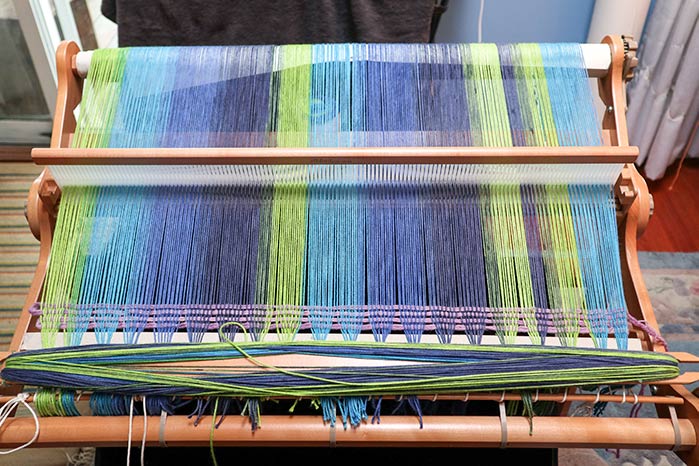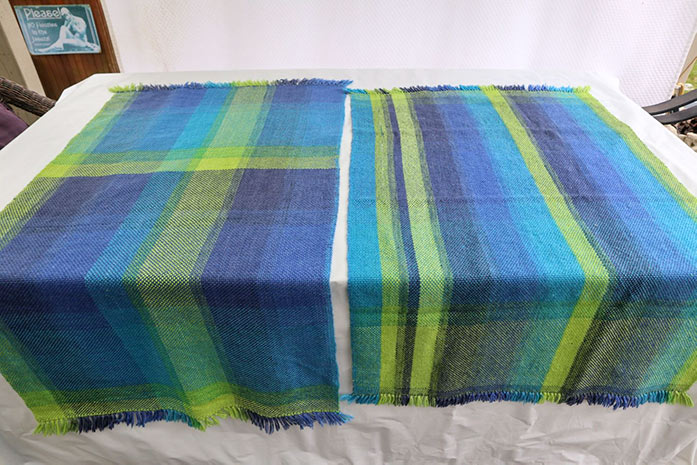This week, I’m knitting with Universal Yarn Cotton Supreme Waves, which is 100%, high-quality cotton in bright self-striping colors.
Yesterday, I made the Lagoon Wrap that showed the long colorways in a diagonal motif. Today, I’m doing something completely different . . . outside of the box, so to speak. I’m making a baby blanket, but I’m not knitting it, nor crocheting it. I’m weaving it on my 28” Ashford Knitters Loom.
Originally I had planned on knitting a blanket that would show off the long color runs in a color block or plaid type effect. But I’ve had a lot of fun experimenting with different yarns on my loom, so I thought, why not try Cotton Supreme Waves in Equator!
I know several weavers that have used self-striping yarn as the warp or the weft, but if you haven’t tried it as both, at the same time, then you’re in for a treat.

Cotton Supreme Waves in Equator – turquoise and bright green are two of my favorite colors.
These colors are fabulous and I must admit, the acid green and turquoise are my two favorite colors for summer, actually any time. They’re bright and cheerful and look good with all skin tones, and genders . . . truly a safe and universal color, and an extremely soft texture for baby.
Before I get started with the details, I’ll just give a couple of weaving facts for the novices. If you’re already a weaver, you know this part, so it’s OK to skip ahead to the details.
Some basic terminology for the novice . . .
Warp – the yarn that runs lengthwise on the loom
Weft – the sideways yarn that is on the shuttle and run through the warp to create the fabric
Shuttle – that’s what you wrap the yarn around to pass it through the shed
Heddle – each thread of the warp is run through the heddle to separate the yarn, also referred to as Reed.
Rigid Heddle – a fixed panel that separates and moves the warp threads. It also acts as the beater to compress the weft threads with each pass.
Shed – the separation between upper and lower warp yarns through which the weft is woven
dpi – dents per inch – the number of warp thread slots & eyelets per inch in the heddle or reed.
OK, enough terminology, let’s get started.
For this project, I used 3 balls of Cotton Supreme Waves, Equator for each blanket. As I mentioned previously, I like to experiment, so I used two different heddle sizes … a 7.5 dpi for one blanket and a 10 dpi for the other. In knitter’s terms, that means 30 warp threads over 4” for the first, and 40 warp threads for the second. This yarn is rated as a Light, which means DK most of the time. It’s actually more of a plump DK, meaning it can act as a Worsted (20 sts = 4”) or a DK (22 sts – 4”) in knitters’ terminology. In weavers’ terminology, it typically means a 7.5 dpi heddle, but I wanted to see what would happen if the warp threads were denser by also using a 10 dpi. The process is the same, regardless of heddle size.
I planned to make each blanket 28” wide by 42” long. Woven fabric will condense once it’s off the loom and washed, therefore my finished blanket will be approximately 10% smaller in both width and length.

28″ Ashford Knitters Loom warped with Equator on a 10 dpi heddle.
The steps
- Direct warp the threads onto the loom – I planned on 45” + 18” waste = 63” warp
- Thread yarn through the eyelets of the heddle
- Tie yarn to the front warp stick
- Run scrap yarn through the warp to even out the threads (the pink yarn)
- Wind weft yarn on the shuttle
- Heddle up, pass the shuttle through the shed (Leave a tail that’s 2 – 3 times the width of your woven fabric. This will be used to hem stitch the first row.), beat; Heddle down, shuttle through, beat; repeat
- Before winding the woven fabric onto the front roller, hem stitch the first row. There are a number of YouTube videos available to learn this technique. Here is a link to Kelly Casanova’s tutorial.
- Once the Hem Stitch is complete, wind the fabric on to the front roller in readiness to continue.
- Put on your favorite tunes and pour a beverage – I find John Fogerty and a good Pinot Grigio is a perfect combination.
- Heddle up, pass shuttle, beat; heddle down, pass shuttle, beat; repeat
- Continue weaving until the last row. Repeat Hem Stitch to secure the last row.

TIP Insert a removable stitch marker every 30 rows. This helps to determine how much fabric has been woven and wound onto the front roller.
I don’t like to waste any warp threads, so I continued to pass the shuttle until there was no possible room left. Then I took it off the loom and tied the warp threads in groups of 3 to create a small fringe.
The finished measurements for each blanket, not including the fringe are:
10 dpi
- 278 Warp Threads, 328 Weft Rows
- 42½” L x 25½” W before laundry
- 39¾” L x 24½” W after laundry
7.5 dpi
- 210 Warp Threads, 376 Weft Rows
- 45¾” L x 25¼” W before laundry
- 43” L x 24½” W after laundry.
The 10 dpi created a slightly thicker fabric than the 7.5 dpi, but the real difference is in the overall look of the two.

The 7.5 dpi blanket (L) has more of a plaid or color block look to it, while the 10 dpi (R) has a subdued weft with prominent warp stripes.
The 7.5 dpi blanket has more of a plaid or color block look to it, while the 10 dpi is more subdued in the weft lines with the warp more prolific creating a vertical stripe look. I’m quite pleased with both of them and they are incredibly soft. The colors are really gender-neutral making them perfect gifts for new babies.
I originally purchased my loom to help manage my plentiful yarn stash. Weaving is so much faster than knitting that I thought I could burn through some stash, but you guessed it, I now have a weaving stash as well. When I look at some yarns, I just can’t help but wonder, “what would this look like woven”.
I really enjoyed making these three projects and showing how a self-striping yarn with long color runs can be used for a variety of projects. By going with smaller needle size, I was able to knit the Tee and Wrap without hurting my hands. The yarn is so soft that it was a pleasure to knit.
My ensemble is complete with the lovely petite Fresh Berries Tee in Heliotrope, the Lagoon Wrap, and two adorable baby blankets in Equator, all made with Universal Yarn Cotton Supreme Waves. Each project illustrates how you can use this self striping yarn to creates some beautiful garments and accessories.
With the long color runs available in 10 different colors it’s sure to put some brightness in your summer knitting (or weaving) projects.

The completed ensemble — Lagoon Wrap with diagonal stripes, Fresh Berries Tee with horizontal stripes, and two color blocked woven baby blankets in Equator — all made with Cotton Supreme Waves.
If you don’t have any Cotton Supreme Waves in you stash, contact your Local Yarn Store (LYS) to see if they stock it, or if they can order it for you. Many LYS’s are offering curb side pick-up or mail orders, and the knitted patterns referenced this week are all available online.
Stay safe and knit your isolation away. Soon we’ll all be back to strutting our knitwear in public.
